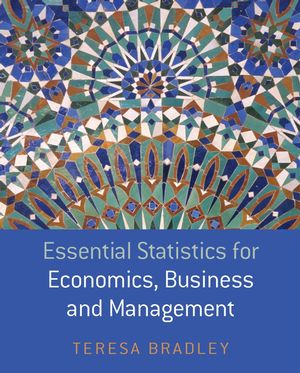|
Textbook
Essential Statistics for Economics, Business and ManagementISBN: 978-0-470-85079-4
Paperback
680 pages
June 2007, ©2006
 This is a Print-on-Demand title. It will be printed specifically to fill your order. Please allow an additional 10-15 days delivery time. The book is not returnable.
|
||||||
CHAPTER 1: Data Collection and its Graphical Presentation 5
1.1 Introduction to statistics 6
1.2 Data collection: Samples, surveys and experiments 8
1.3 Some sources of statistical data 16
1.4 Sorting and classifying data 18
1.5 Charts: Bar charts, pie charts and plotting in Excel 23
1.6 Graphs: Histograms and Ogives. Graphs in Excel 42
1.7 Line and Lorenz graphs 52
1.8 Misleading graphs 59
CHAPTER 2: Descriptive Statistics 63
2.1 Summary statistics for raw data: Mean, quartiles and mode 64
2.2 Summary statistics for grouped data: Mean, quartiles and mode 72
2.3 Measures of dispersion for raw data. Variance, QD, IQR 85
2.4 Measures of dispersion for grouped data. Variance, QD, IQR 92
2.5 Use of calculator for descriptive statistics 94
2.6 Other descriptive statistics. CV, skewness and box plots 96
2.7 Descriptive statistics in Excel 101
CHAPTER 3: Regression and Correlation: Introduction 113
3.1 Introduction to regression: Scatter plots and lines 114
3.2 The least-squares line. Criteria and equation for the best fit line 118
3.3 Excel: XY (scatter) plots, the least-squares lines and formulae 127
3.4 Coefficient of determination and correlation 133
3.5 Rank correlation. Calculate and interpret rank correlation 144
3.6 Use the calculator for linear regression and correlation 146
3.7 Why bother with formulae? 154
CHAPTER 4: Probability 159
4.1 Introduction to probability 159
4.2 Multiplication and addition rules for probability 170
4.3 Joint, marginal and conditional probability 184
4.4 Bayes' Rule 192
CHAPTER 5: Introduction to Probability Distributions 205
5.1 Introduction to probability distributions and random variables 206
5.2 The Binomial probability distribution 212
5.3 The Poisson probability distribution 228
5.4 The Normal probability distribution 236
5.5 Expected values (mathematical expectation) 253
CHAPTER 6: Sampling Distributions for Means and Proportions 265
6.1 Statistical inference and the sampling distribution of the mean 265
6.2 Sampling distribution of proportions 275
6.3 Some desirable properties of estimators 282
CHAPTER 7: Confidence Intervals for Means and Proportions 287
7.1 Confidence intervals for the mean 287
7.2 Confidence intervals for proportions 297
7.3 The precision of confidence intervals for the mean 300
7.4 Confidence intervals for differences between means and proportions 304
CHAPTER 8: Tests of Hypothesis for Means and Proportions 319
8.1 Hypothesis tests for means 319
8.2 Hypothesis tests for proportions 334
8.3 Hypothesis tests for the difference between means and proportions 337
8.4 Minitab and Excel for confidence intervals and tests of hypothesis 349
CHAPTER 9: Inference from Small Samples. Confidence Intervals and Tests of Hypothesis 359
9.1 Inference from small samples: Normal populations, s known 360
9.2 The Student's t distribution 362
9.3 Inference from small samples: Normal populations, s NOT known 365
9.4 Difference between means. Small independent samples 370
9.5 F-test for equality of two variances 378
9.6 Difference between means, paired samples 382
CHAPTER 10: Analysis of Variance 393
10.1 The rationale behind one-way analysis of variance 393
10.2 One-way analysis of variance 397
10.3 Two-way ANOVA 419
10.4 ANOVA and design of experiment 430
10.5 Excel and Minitab for ANOVA 435
CHAPTER 11: Chi-squared Tests 453
11.1 Introduction 454
11.2 The ?2 probability distribution 454
11.3 Contingency tables 455
11.4 ?2 tests for independence (no association) 456
11.5 ?2 test for homogeneous populations 464
11.6 ?2 tests for the equality of several proportions 466
11.7 Goodness of fit tests 478
11.8 ?2 tests in Minitab and Excel 490
CHAPTER 12: Regression Analysis 499
12.1 The simple linear regression model 499
12.2 Inference about the population slope (rate of change) 504
12.3 Confidence intervals and prediction intervals at x = x0 513
12.4 Checks on the model assumptions based on residuals plots 518
12.5 Regression analysis in Minitab and Excel 521
12.6 Multiple regression 534
APPENDIX A: Technicalities and Conventions for Defining Class Intervals, Mid-Interval, Widths, Limits, Boundaries 545
APPENDIX B: Formulae for Calculating the Quartiles for Grouped Data 547
APPENDIX C: Outline of Derivation of Formulae (3.2) and (3.3) for the Slope and Intercept of the Least-Squares Line, Y = a + bX 549
APPENDIX D: Brief Review of the Mathematics for the Binomial 551
APPENDIX E: The Number e 555
APPENDIX F: Calculation of Mean and Variance of Proportions by Expected Values 557
APPENDIX G: Confidence Intervals for Means and Proportions 559
APPENDIX H: Degrees of Freedom 561
APPENDIX I: Notes on Summations and Double Summations 563
APPENDIX J: Expressing the Estimates of Variance as Sums of Squares Divided by Degrees of Freedom in Their Simplest Form 567
APPENDIX K: Sums of Squares for the One-Way ANOVA 571
APPENDIX L: Fitted Values and Residuals 573
APPENDIX M: Sums of Squares Identity for Two-Way ANOVA 575
Chapter Solutions 577
Tables 637
Table 1 Cumulative Binomial Probability tables 637
Table 2 Cumulative Poisson Probabilities 639
Table 3 Normal probability Distribution 641
Table 4 Percentage point for the Normal probability distribution 642
Table 5 Percentage points of the Student’s t-distribution 643
Table 6 0.5% points of the F-distribution 644
Table 7 Percentage points for the Chi-squared distribution 648
Table 8 Table of random numbers 649
Glossary 651
Index 653



